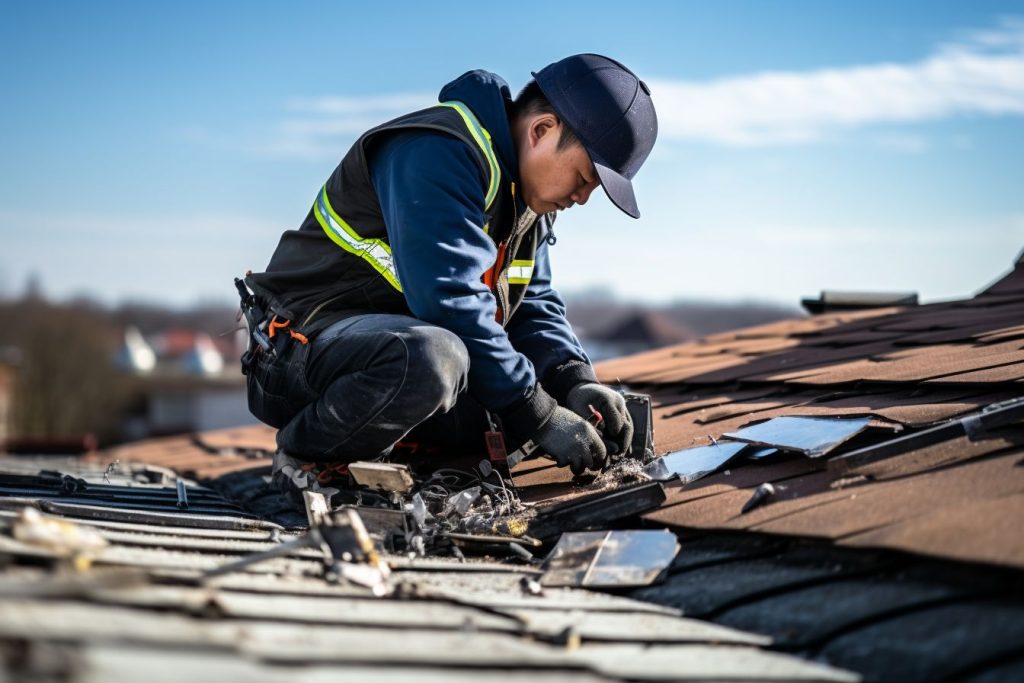Dealing with a damaged flat roof can be frustrating and costly. Despite its name, a flat roof isn’t completely flat but has a slight pitch to aid in water runoff. This article offers practical guidance on repairing your flat roof, from locating the damage to applying patches and resealing.
Let’s fix that leaky roof together!
Key Takeaways
- Locating the source of a leak on your flat roof is the first step in repairing it. Use tools like binoculars or drones to inspect the roof closely without climbing up.
- Seal small cracks and holes with caulk or roofing cement to prevent further damage and potential leaks.
- Apply membrane patches or adhesive patches for larger areas of damage, and reseal the entire roof to ensure it is waterproof.
- Regular maintenance is crucial for preventing water damage on flat roofs. Inspect the roof regularly for signs of wear or damage, and keep detailed records of all maintenance and repairs done.
Steps for Repairing a Flat Roof
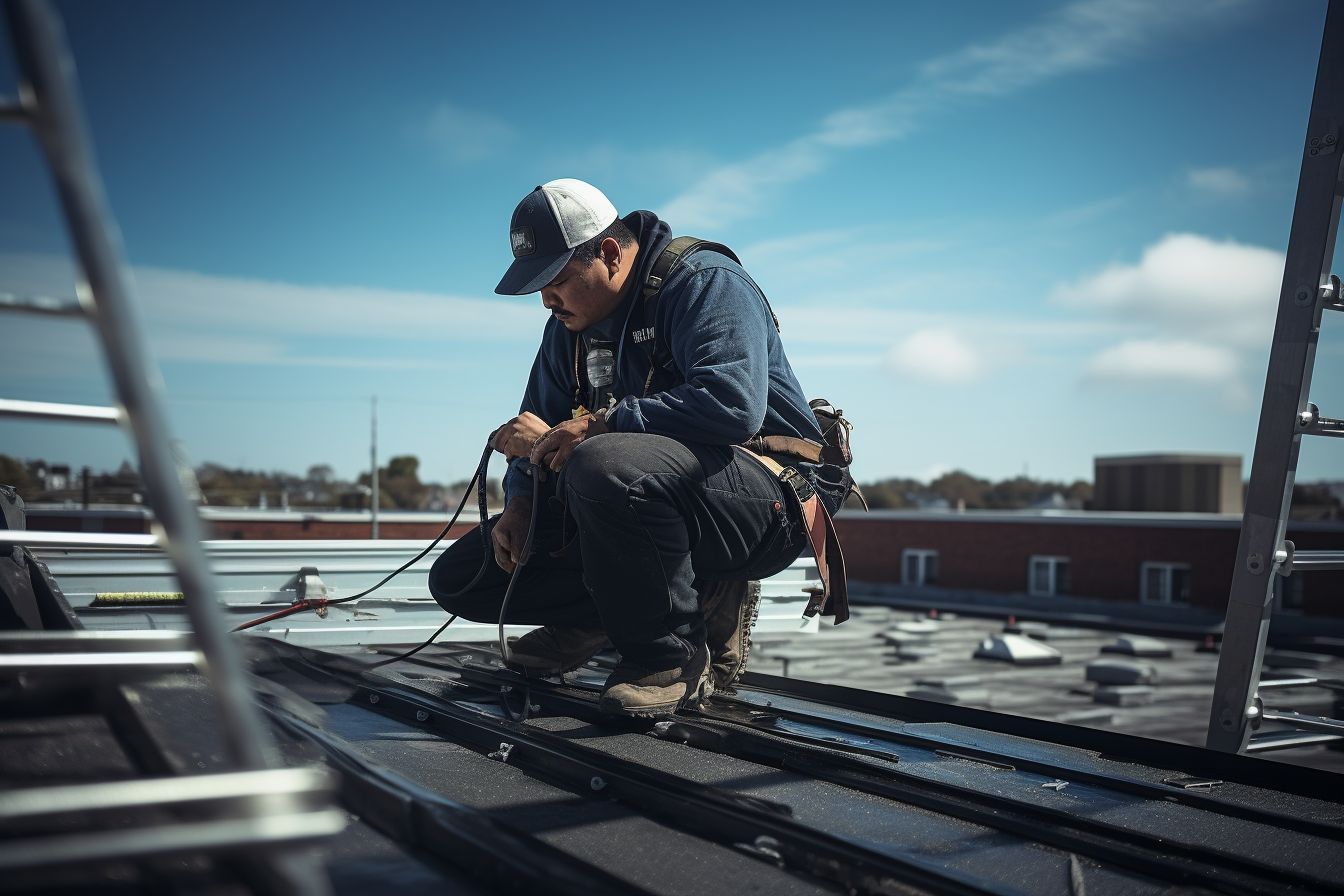
To repair a flat roof, follow these steps: locate any damage on the roof, seal small cracks and holes with caulk or roofing cement, apply membrane patches or adhesive patches for larger areas of damage, and reseal the entire roof to ensure it is waterproof.
Locating Roof Damage
Finding the source of a leak on your flat roof marks the initial step in its repair. Using tools like binoculars or drones helps to inspect the roof closely without climbing up. Look for signs such as cracks, holes, blisters or punctures, and pooling water.
A utility knife comes in handy when removing parts of roofing around damaged areas. Please always clean these areas before starting repairs for the best results. Bigger damages may need more than just repairing; it could initiate considerations about a complete roof replacement! You can evaluate both situations – painstaking repair versus cost-effective total replacement – and select the wiser path forward with your flat rooftop issues.
Sealing Small Cracks and Holes
Dealing with small cracks and holes is a crucial aspect of flat roof repair. Here’s a simple guide:
- Locate the small holes or cracks on your flat roof.
- Use caulk to seal these damages if they are less than an inch wide.
- Cover any larger holes using self-adhesive flashing or rubber tape to secure the area.
- Apply EPDM primer on the surface where you want to attach a patch.
- For puncture holes or small tears, roofer’s caulk is beneficial for sealing.
- Lastly, apply a top coat of wet patch to extend the durability of your repair beyond the lower area of your flat roof.
Applying Roof Patches
Applying roof patches stands as a critical phase in the process of repairing flat roofs.
- Start by locating all cracks and gaps on the roof surface. Ensure every damaged spot gets identified for proper repair.
- Once the damage is located, seal the area using materials like fibreglass mesh or membrane patches.
- For optimal results, apply caulk or roofing cement to these meshes or patches.
- Next, use a putty knife to apply a top coat of wet patch over these sealed areas. This helps reinforce their strength and durability, greatly reducing future damage.
- Do not restrict the application of the wet patch; extend it at least two to four inches beyond the lower area of damage.
- If dealing with tar and gravel roofs, follow a different method. Here, you need to apply tar to damaged regions using a caulk gun.
- After applying tar, smooth out the area with a putty knife or brush, ensuring an even coverage over all cracks or gaps.
- Following smoothing, cover each treated spot completely for protection.
- Another effective method includes coating these spots with roofing cement before applying new patches.
- Always weigh the decision to repair versus replace your flat roof carefully, considering specific challenges associated with this roof type.
Resealing a Roof
To reseal a roof, follow these steps:
- Clean the roof surface thoroughly using a broom or pressure washer.
- Inspect the roof for cracks, gaps, or loose areas.
- Apply roofing cement or caulk to seal small cracks and holes.
- Cut fibreglass mesh to fit over larger gaps and press it into place using a putty knife.
- Use membrane patches to cover damaged areas and secure them with roofing cement.
- Apply an additional layer of roofing cement over the patched areas for extra protection.
- Extend the wet patch beyond the lower patch during application to ensure proper coverage.
- Allow the roof to dry completely before resealing it with waterproofing paint or another sealer.
Tips and Warnings for Flat Roof Repair
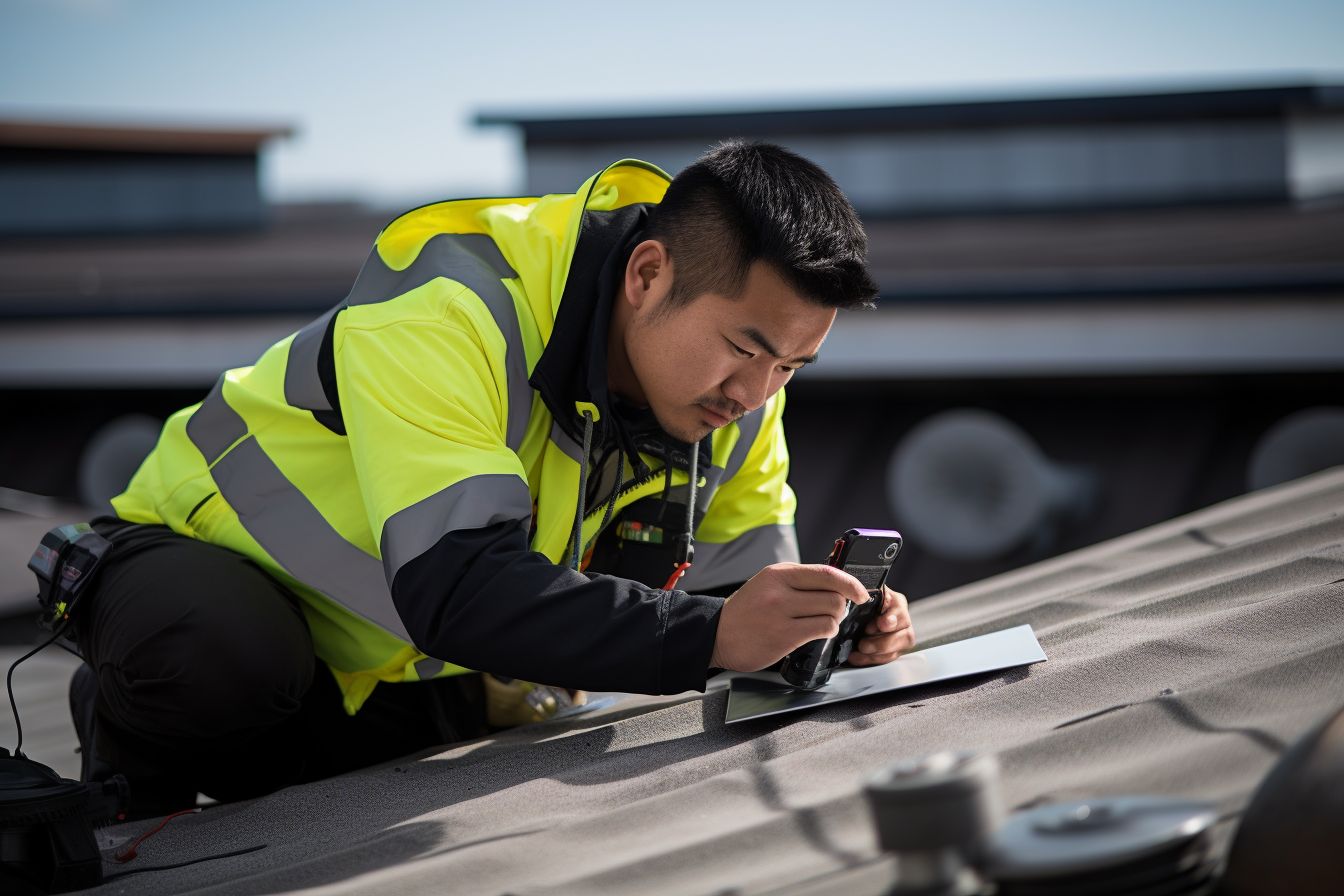
Regular maintenance is crucial for preventing water damage on flat roofs. One important tip is to regularly inspect the roof for any signs of wear or damage, such as cracks or pooling water.
It’s also essential to keep detailed records of all maintenance and repairs done on the roof, as this can help identify recurring issues and determine when it may be time for a replacement.
Also, when fixing a flat roof, please use the appropriate roofing material and follow the manufacturer’s instructions carefully. Avoid using excessive force when sealing cracks or applying patches, as this could cause further damage.
Finally, please keep in mind of trapped moisture and overheating on flat roofs, as these can lead to serious problems if not addressed promptly.
Ensuring proper care and following these tips can extend the lifespan of your flat roof and prevent costly repairs down the line. Please stay proactive in your maintenance routine so that you can detect any potential issues early on and address them effectively.
Considering these precautions, you can ensure that your flat roof remains durable and watertight for years to come.
Flat Roof Repair Costs
Flat roof repair can greatly vary in costs depending on the damage’s extent and your property’s specific needs. Below, I’ve included a detailed breakdown of the potential costs you may encounter when you’re able to repair a flat roof.
| Type of Expense | Average Cost |
|---|---|
| Basic Repair Costs | $300 – $1,100 |
| Average Repair Costs | $700 – $750 |
| Extensive Damage Repair Costs | Up to $2,550 |
| Roof Replacement Per Square Foot | $4 – $30 |
| Roofer’s Labor Costs per Hour | $40 – $80 |
| Timeframe for Flat Roof Replacement | About five days |
Remember, these costs can fluctuate based on the project’s complexity and the roof’s size. It’s always a good idea to consult a professional for an accurate quote.
Additional Resources for Flat Roof Repair
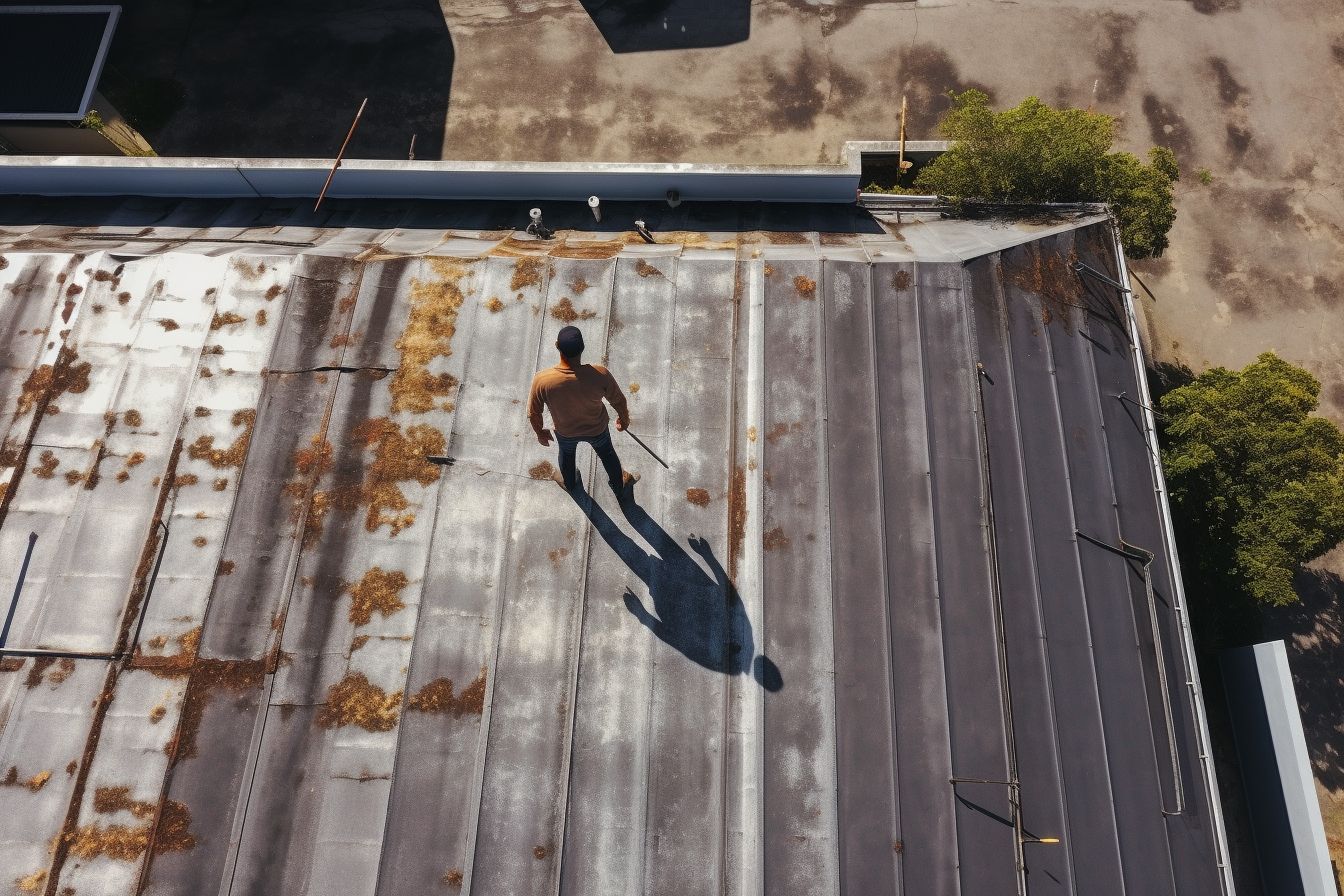
Flat roof repair can be a complex task that may require the expertise of roofing professionals. If you need additional resources for flat roof repair, several options are available to help you tackle this project efficiently and effectively.
One valuable resource is professional flat roof maintenance services. These experts specialise in identifying and resolving common issues such as leaks and damaged roofing materials.
They have the necessary knowledge and equipment to conduct thorough inspections, identify potential problems, and provide appropriate solutions.
In addition to professional assistance, numerous online resources are available for DIY enthusiasts. Websites and blogs offer step-by-step guides on repairing a leaky flat roof, providing tips on locating the problem’s source and offering recommendations for suitable repair methods.
You can find detailed instructions and helpful visuals that will guide you through each stage of the repair process.
Remember that regular maintenance is crucial for managing a flat roof effectively. By keeping detailed records of maintenance activities, repairs, and inspections, you’ll better understand your roof’s condition over time.
This documentation will serve as an invaluable resource when planning future repairs or replacement projects.
Whether you choose professional assistance or tackle the repairs yourself, it’s important to use high-quality roofing materials, such as waterproofing sealants specifically designed for flat roofs.
These products help prevent future leaks by creating a protective barrier against water infiltration.
With these additional resources, you can promptly address any issues with your flat roof while minimizing costs in the long run.
Conclusion
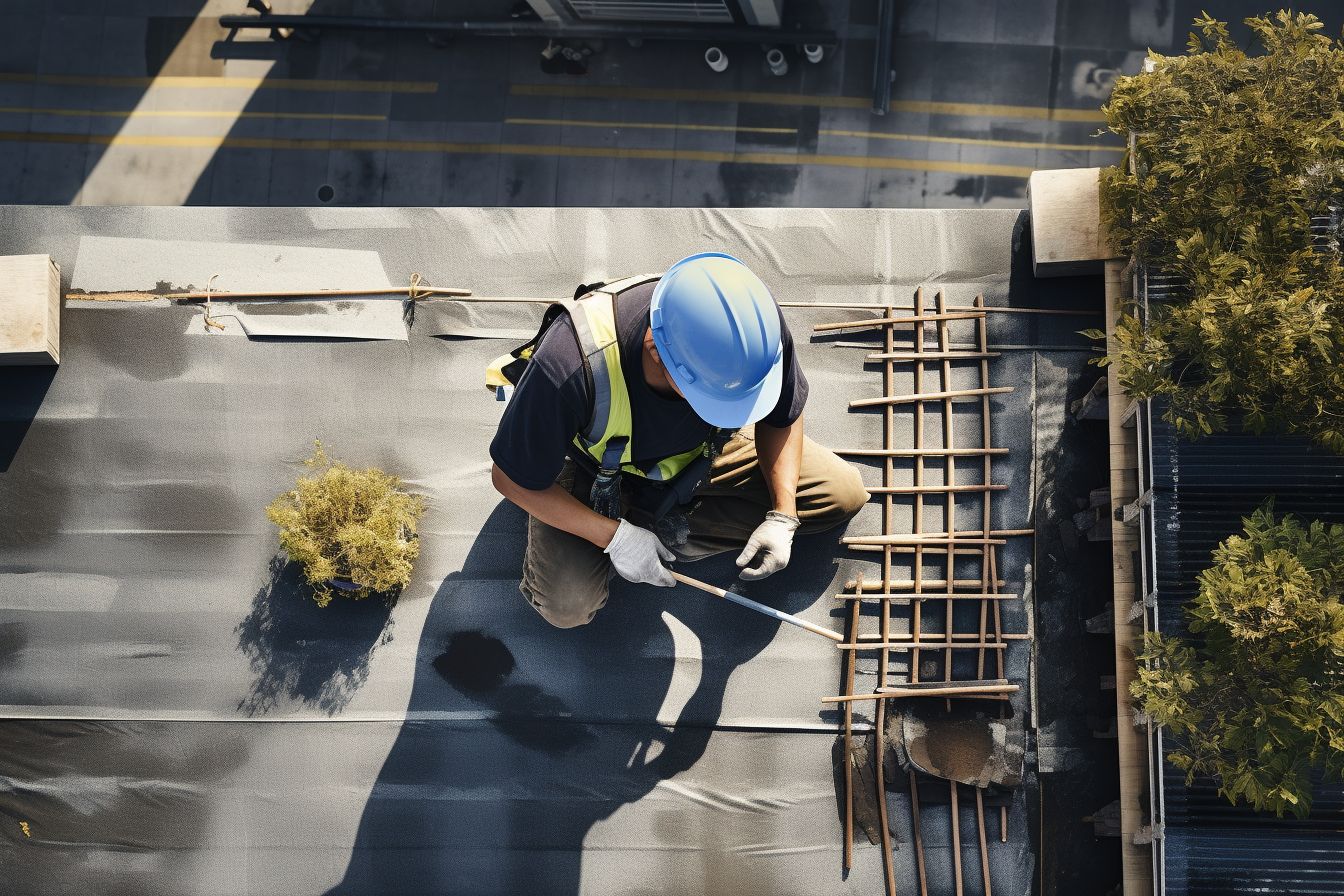
Repairing a flat roof requires careful attention to detail and the right tools. By following the steps outlined in this article, you can effectively locate and repair damage, ensuring your roof remains strong and leak-free.
Remember to take necessary precautions and seek professional help if needed. With proper maintenance, your flat roof will last for years to come.
FAQs
1. Can I repair a flat roof myself?
Yes, you can repair a flat roof if the damage is minor and you have basic DIY skills. However, it’s important to consult a professional for larger repairs or if you need clarification on the extent of the damage.
2. How do I identify a leak on my flat roof?
You can identify a leak on your flat roof by looking for signs such as water stains or dampness on the ceiling, bubbling or peeling paint, or visible cracks in the roof surface.
3. What materials do I need to repair a flat roof?
To repair a flat roof, you will typically need roofing cement or sealant, patching fabric, roofing nails/screws, and a trowel/brush for application.
4. How long does it take to repair a flat roof?
The time required to repair a flat roof depends on the size and complexity of the damage. Minor repairs may take just an hour or two, while more extensive repairs could take several days.
5. Should I replace my entire flat roof if there is only one area of damage?
It is not necessary to replace your entire flat roof if there is only one area of damage. In most cases, localized repairs can address specific issues without requiring full replacement. However, consulting with a professional roofer is advised to assess the extent of the damage and determine an appropriate course of action.

